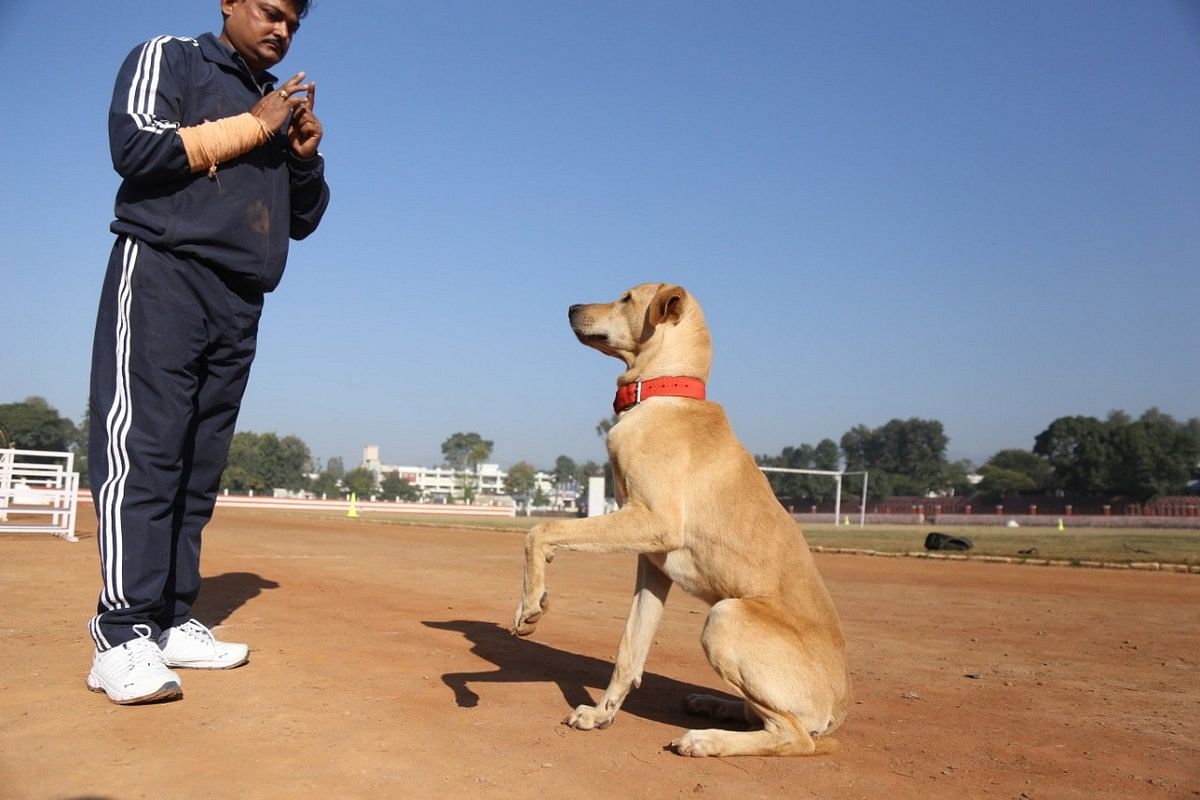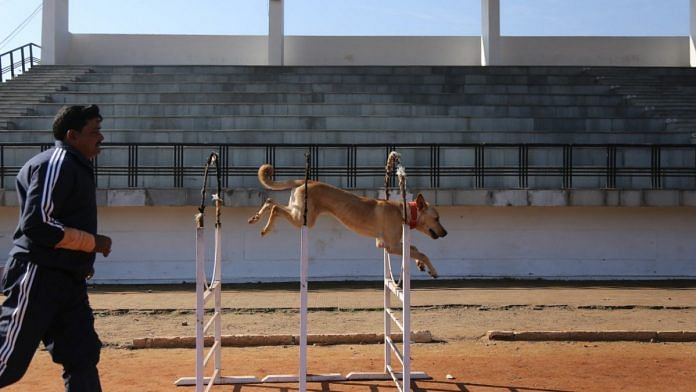Dehradun: For an eight-month-old dog, Thenga behaves extraordinarily well: He greets visitors with a ‘namaste’, sits politely, and doesn’t make a sound unless asked to. Thenga doesn’t know it, but he achieves far more than just coming off as well-behaved — he’s subverted the belief that decrees his kind incapable of discipline.
Thenga is a mongrel, or an Indian pariah dog — the first to be officially recruited by the Uttarakhand government to help police detect explosives and narcotics and track missing persons. Traditionally, the elite dog squad is reserved for Western breeds like the Labrador or the German Shepherd.
“We brought him to the training centre as an experiment, but he’s exceeded everyone’s expectations by miles,” said Kamlesh Pant, chief of Uttarakhand’s bomb detection and dog squad. “He’s performing much better than the other dogs in training.”
Thenga is tall and skinny, with a face that loosely resembles a Labrador’s, and two extra toes. Pant says Thenga’s long, thin frame helps with his performance — for every one hoop that a Labrador or a German Shepherd jumps through, Thenga glides through three.
“The other dogs can jump about four feet high, but Thenga has no difficulty doing five feet,” said Ram Dutt Pandey, Thenga’s main handler. “We don’t give him any special treatment — he’s just naturally more agile.”
Pant, along with Inspector General Sanjay Gunjayal, decided to train Thenga after Pant’s daughter brought him home from the streets. Thenga’s food and maintenance was paid for by Pant and Gunjayal until the State Disaster Response Force (a unit derived from the police and other essential services), impressed by his performance, also decided to recruit him as a rescue dog.
“After his training, he will be tasked with tracking missing persons as well as rescuing people in disaster situations. His trainers will have to move with him,” said Pant.
Also read: ‘Survival of the friendliest’ – How being docile help humans and dogs to thrive
A master at tracking
Each dog has two trainers — a main handler and an assistant — who must be with the animal from the time they are recruited, at about 5 months old, until their death. Police dogs spend the first year of their lives with their main handlers, until they are well acquainted with the hand that feeds them. As for the trainers, they must volunteer and be prepared to take on a 12-to-13-year responsibility.
Thenga is Pandey’s first pariah dog, and when the opportunity to train him presented itself, he couldn’t resist the challenge. “Mr Pant asked me if I would be able to train him, and I said, absolutely,” Pandey said.

Police dogs are trained for three different purposes — tracking missing persons, sniffing for explosives, and detecting narcotics. Each requires a three-month basic training, but tracking is the most gruelling, with an additional six-month course.
Thenga was chosen to track because, what the other dogs took months to master, he learned in 20 days.
“It was shocking. He picked up the basic tracking exercise faster than I’ve ever seen,” said Pandey.
Pandey was himself trained at the National Training Centre for Dogs (NTCD) in Gwalior, Madhya Pradesh, under the Border Security Force. His assistant, Prem Ballabh, was also trained there, and both joined the Uttarakhand Police in 2002.
Ballabh and Pandey say the police relies heavily on dogs when it comes to tracking people and explosives. The NCTD has trained over 3,499 dogs since it was established in 1970
“There’s a machine that can detect explosives, but they cost some Rs 16 to 20 lakh and they’re efficient about 60 per cent of the time. There’s no machine to find people on the run — only dogs can do that with speed. And a dog like Thenga was free!” said Pant.
Also read: What makes Belgian Malinois, the dog that chased al-Baghdadi to death, special
Why pariahs are a gamble
Apart from Labradors and German Shepherds, the Army and police also rely on the Belgian Malinois, the Cocker Spaniel, and the Doberman Pinscher — all of which are expensive, ranging from Rs 30,000 to Rs 1 lakh per dog.
Only breeders approved by the Kennel Club of India and Animal Welfare Board are considered for recruitment by the forces. Pant said prior to a dog’s selection, trainers look at least four generations of the dogs’ family trees to ensure that they possesses the traits most suitable for sniffing.
Thenga’s induction, in comparison, was a complete gamble.
“Bred dogs are genetically predisposed to do what we want out of them. The Malinois, for example, is naturally predisposed to using its mouth, which makes it appropriate for tracking and guarding,” said Shirin Merchant, a professional canine trainer and behaviourist.
“Sometimes knowing the breed and parentage of the dog can help us predict the outcomes of the dog’s training and temperament. Through that, the chances of the dog failing in that work are much lower. Working with a dog we know nothing about could require more time, money, and effort to train, because they’re not predisposed to that work,” Merchant added.
DIG M.L. Ravindra, who leads the Central Reserve Police Force’s Dog Breeding and Training School in Bengaluru, said the forces have relied on pariah dogs informally for years, but that their formal induction may not be so smooth.
“This isn’t the first time a street dog is being used in the forces — there are cases in West Bengal and Bihar as well. The results have varied across each case. If we begin to recruit pariahs, we would have to come up with a set of standards,” Ravindra said.
Pant, however, is certain that the Uttarakhand Police will recruit more street dogs to fight crime.
“They certainly should be recruited on a larger scale. Thenga has proven that they are more than capable of it, and we will repeat this experiment again,” he said.
Also read: Your stress is most likely stressing your dog out too







It should come to no surprise that Pariahs are highly trainable. Humans and Pariahs have at least 10K yrs of co-evolution and natural selection. If I recall correctly, a breed guide has been released by The Kennel Club of India; we should stop calling it a mongrel 🙂
This is great news. Pariahs are indigenous hence better suited to the sub-continental climate, and hardier. It’ll be interesting to see how well they perform at specific tasks of sniffing, tracking etc… in comparison to other breeds.
But ultimately, the bottom line for any coworker is how well you get along with them. Pariahs are sure to win on that front 🙂